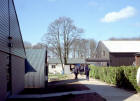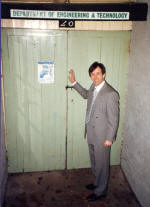Contents
![]() The Gallery
The Gallery
![]() Construction & Demolition
Construction & Demolition
![]() Hut
26 Overwhelmed
Hut
26 Overwhelmed
Click on thumbnail photos to see larger versions & use your Browser's <back> button to return
A mid-50s photo taken from the top of the water tower. 26 is arrowed. 1950s pupil Brian Turner stands at the entrance of his old home in 1986. Hut 26 was built in 1943 and served as an Officers' Ward of the United States Army Air Force (USAAF) 77th (later 231st) Station Hospital until its closure in June 1945. For most of the next five years, 26 was part of 'Butler Court,' the accommodation area for men undertaking emergency training courses to meet the post-war National shortage of teachers. As Dorm 26, the hut was home to many Wymondham College boys through the Fifties and well into the Sixties, when it then formed part of overspill accommodation arrangements until New Hall was opened in 1967. Dorms 26-31 were connected by a fully enclosed covered way that was built c1952 and mostly demolished in 1977 (see the 'bath' photo back on the Construction & Demolition page), but as the 1986 photo shows (above), the ramp down to 26 retained its brick walls for some time after.
A drawing of the hut's internal layout, when used as a dormitory in the 1950s, is on the Maps & Plans page. The end third of the hut closest to the covered way was divided by brick and block walls into bathrooms, toilets, a shoe room, luggage room and (perhaps) quarters for Matron and/or single staff. There was also a room at the opposite end for extra beds or recreation. This is where nightly cocoa and buns were dished out just before bedtime.
The floor in the main dorm section was corticene (brown lino) and the beds (for 26 boys + maybe a couple of House Prefects) were military surplus iron variety, with a mattress approximately 3 inches thick. There was also the luxury of a small grey bedside mat. Counterpanes were ex-Navy faded blue/white, complete with a central anchor design. Furniture comprised a chest of drawers (with mirror) and a small wardrobe per boy. Only slippers were allowed in the dorm, hence the shoe room by the covered way entrance.
"When its use as a dormitory ceased, 26 was used by the language department (mostly French with a bit of German for some). I can remember many (boring) lessons watching the Longman's audio-visual material and reciting the accompanying texts. Beep (next picture). What a fascinating life those characters led! The stories of Marie-France, Jean-Paul and Claudette ... oh what fun! Beep (next picture). The windows needed the curtains drawn so we could see the picture slides projected on the screen in front. The curtains were likely left over from the days of it being a dorm and I recall the labs also having them. Can't remember any other classrooms having curtains. I'm not sure when the Technology Department moved in; perhaps it had some sort of rotation arrangement with the workshops moving out of the block huts next to the pond (to where?) and then languages moving in to the old workshops and so on. 26A was my form room (1A) in 68/69 and later I had room 26C as a form room (3C). It was my impression, but I have no practical experience here to confirm this fact, that the end rooms of this block and especially 26B and 26C were favourite locations for illicit romantic trysts after school! This location was close to the boarding houses and tuck shop, a safe distance away from the staff hut and also the entrances were partially obscured by vegetation growing up that part of the covered way adjacent to that hut as I remember."
Steve Grant
There's just landscaping left to do and 26's days are numbered.
Summer 1997, looking South along the side of the Tech Drawing office (ex-morgue), now the site of the USAAF Memorial Garden. In the modern photos (taken on 2 different occasions by David Spinks), 26 has been shortened to make way for Phase 2 of the Technology Block (Art & Design rooms). A grant had been obtained early in 1997 and the block was opened officially on 7th May 1999, so we would guess that most of these photos were taken in 1998 when the work was well advanced. In its truncated form, 26 is understood to have continued briefly as a small boiler room and toilets.
 |
This shows 26 in the context of the present-day buildings. The main path looks to be in exactly the same position and height as the old covered way, which was fully enclosed at this point. |











